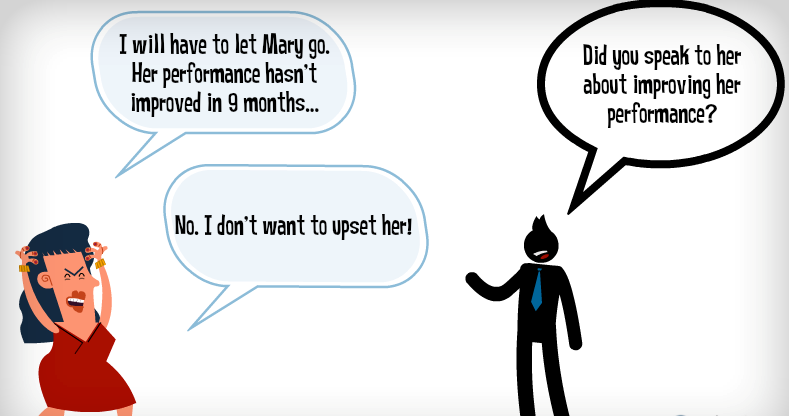How can you tell the truth about a situation without fearing rejection, or disagree with someone without causing offence? We tell ourselves that these conversations are difficult because we don’t want to upset the other person. In fact, the slightly sick feeling we get is less to do with them and more to do with our internal dialogue about what we think could happen.
Our basic nature is to avoid potential unpleasantness. Tough conversations in high-stakes situations can often put us into a “fight or flight” state where we’re likely to turn to silence or violence — to withdraw and avoid the conflict or lash out in a hostile way to defend ourselves. Neither way is healthy, and almost always makes the problem worse.
This is completely natural and part of the human experience!
If you have experienced this, then you can use your experience to create an effective approach to having the actual conversation. It involves all aspects of you – your head, your heart and some gusty courage.. 
Creativity
People often times do not have a thought-out strategy or plan. In previous blogs, I have provided you with some useful steps to help you plan an effective approach and to manage your emotions so that they do not get the best of you.
But even the best plans, strategy or practical steps can be useless if our emotions take over.
As human beings, we all are capable of being rational and logical. We all experience emotions. And we all have experienced times when we have gotten defensive, wanted to stand our ground or get away and feel safe.
We need to learn how to use ALL aspects of our human nature, and bring them together so that these aspects work together. If not, one or more will dominate and one or more will be excluded. This happens, for example, when our negative emotions are running so high we cannot ‘think straight’, and we forget to follow our wonderful strategy!
Another example is when we have the plan, mapped out our steps, have our emotions in check and we’re calm and focused, but then we just don’t have the courage to say what we really want to say! We are too scared!
Let’s see how we can put all this together.
With the worksheet for the Alive & Kicking 7 steps to challenging conversations sit down and complete each step, from #1 up to #5. Use your head to find creative ways to think about the questions posed in each step. What else can you think of? And what else?
Your head is capable of finding solutions if you allow yourself to be curious, let yourself act as if you can find a workable solution, remove your limiting thoughts while you work through the 5 steps.
Compassion
I have emphasised the need to view the situation – and the other person – from a neutral perspective. That is, to check your emotions so that they do not take over your ability to be rational and logical. I also mentioned the need to ensure you are wearing the appropriate ‘hat’ for the conversation.
All this is the domain of your head – use it to its full capacity for creativity and rational thought.
Now let’s get in to the actual conversation – this is what you really want, right?
Courage
One of the reasons we have a visceral reaction is our body’s self-protective mechanism. This is our autonomic nervous system (ANS) at work, and when we want to take flight or stand our ground and fight our sympathetic branch of the ANS takes over automatically. Our body’s ability to sense danger and mobilise us in to action is physically located in our gastrointestinal tract – more specifically, in our gut.
Have you ever heard the term ‘gutsy courage’? Or described someone as having ‘guts’ to take action? What these phrases refer to is the neurological wiring of our gut, where there are up to 500 million neurons that communicate up the vagus nerve to the head, conveying important information like “danger! Need to take action!”
Flight or Fight is the domain of the GUT
When a difficult situation arises and we feel the urge to run (or fight), we can work with the signal we feel and get the gut to check in with the head and review the plan. This is an example of aligning our head with our gut. Put in other terms, this is a way to check our initial nervous response received from the ANS with the facts of the situation – there is a logical, rational way to approach this situation.
When we check the facts, the nerves can settle, and the gut can then choose a different course of action.
When we check back in with the gut, after reaffirming we have a good plan and strategy, the gut can now find reason to have courage to move forward and face the conversation with confidence.
We have a plan and can now access courage, because our fears have been allayed with our strategy.
The Ripple Effect – the role of the HEART
The vagus nerve runs right next to the heart, the seat of all our emotions. It is also where we access what is truly important to us, what we value most in our lives. It is not the head that tells us how we feel about someone, it is our heart.
If we really want to be successful in having difficult conversations, we need to involve the heart. This is as simple as considering why it is important to us to have the conversation. Why is it truly important to you to have this conversation with the other person?
To activate our courage, we simply need to be compassionate. Compassion is activated within us when we extend our emotions to others, and when we act upon those feelings. This is the heart and the gut working together.
It may seem easier in the short term to avoid bringing up a difficult issue or highlighting a problem with performance, but the long-term consequences are tremendous. Avoidance can lead to full on disconnection and breakdown of trust.
And guess where trust exists in you?
You got it – the heart! Without trust, we cannot access emotions with and for other people. When we disconnect from our heart, then our head and gut take over.
it – the heart! Without trust, we cannot access emotions with and for other people. When we disconnect from our heart, then our head and gut take over.
If you want to be truly effective and find workable solutions, you must use your head – and your heart – AND your gut, together.
Step 6
As you go through the worksheet, ensure your heart is at peace when you plan to have the actual conversation. Set aside the thoughts your head is sharing, and take a breath to calm the butterflies in your belly. And allow yourself to feel compassion in your heart.
Then extend this compassion to the other person – you do not have to love this other person, but if you allow yourself to feel positive emotions toward them, you will be able to resolve just about anything with them.
When you feel a connection to the other person (heart), then get curious (head). Ask yourself what don’t you know about their perspective, their point of view, how they see the situation. Allow yourself to really wonder what is really important to them in this situation, as you still feel compassion in your heart. When you identify the truly important stuff, your courage will surface. You will not be able to NOT have the conversation now!
Try this, and see where your conversation takes you.
Step 7
The final step in having confidence and success with difficult situations is to review what you did. What can you pat yourself on the back for? What did you do really well? What efforts did you make of which you are very proud?
What would you do the same? And what would you do differently?
Reflect on the strategy you have now developed to deal with what you once considered to be difficult. These sorts of conversations may never be easy, but they do not have to cause stress and frustration. With the 7 steps to challenging conversations you now have a great way to manage challenging human interactions with more confidence.
Time and Effort
Are you going to stumble and make mistakes now and then? Yessiree! You sure are! And it is through the mistakes we make as we are applying the skills we learned that we get to be able to use these skills smoothly, unconsciously, and arrive at the desired destination.
We would love to hear your success stories and answer your questions on this topic. Please contact us at: hello@aliveandkicking.com.au





 Now think about what ‘hat’ you need to wear to have this conversation. And how you will ensure the other person is clear what hat you are wearing. If we are not sure of what hat we are wearing, it will be confusing to those we interact with. And we are likely to confound the matter by playing different roles.
Now think about what ‘hat’ you need to wear to have this conversation. And how you will ensure the other person is clear what hat you are wearing. If we are not sure of what hat we are wearing, it will be confusing to those we interact with. And we are likely to confound the matter by playing different roles.

